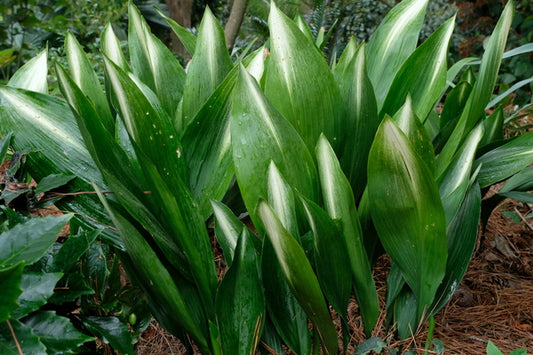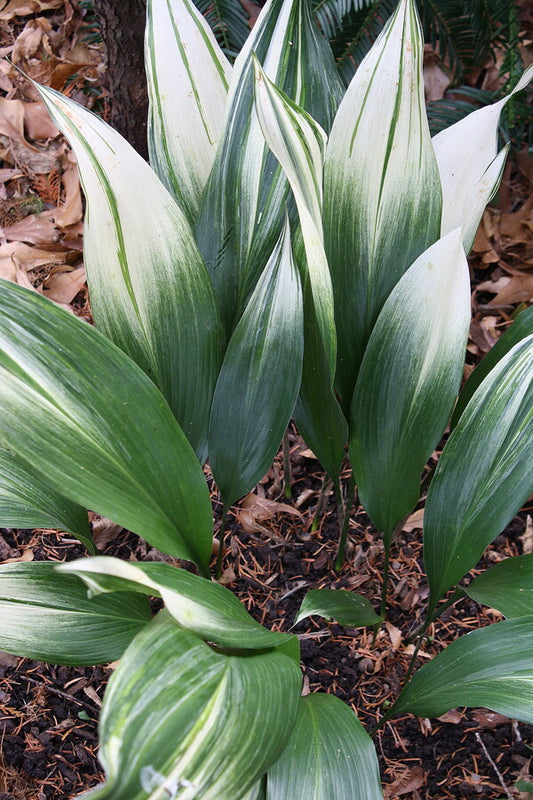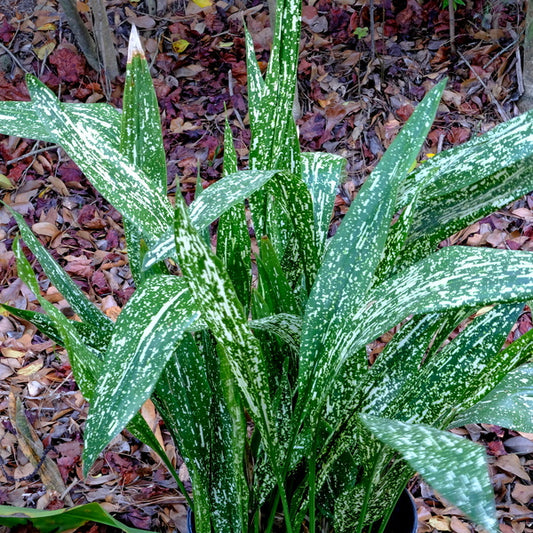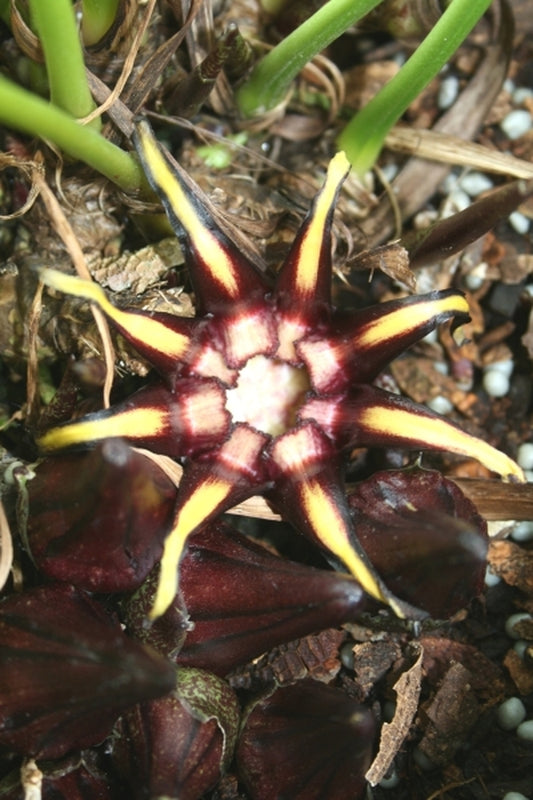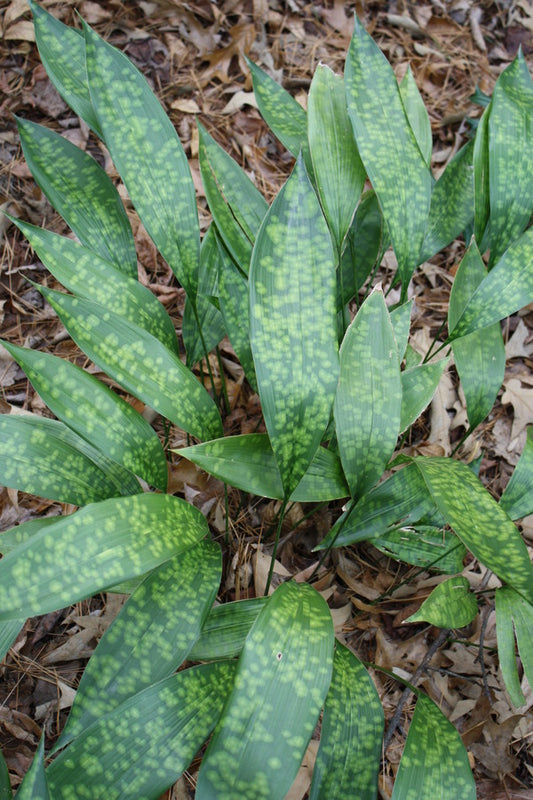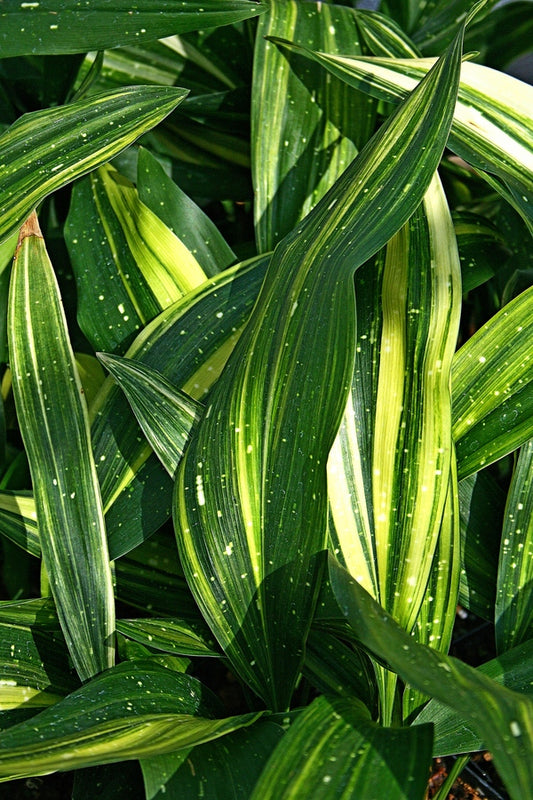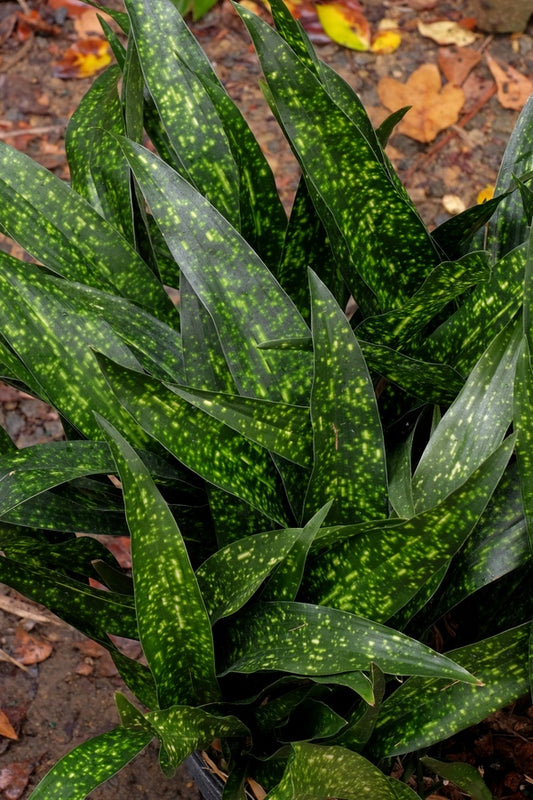We have been collecting aspidistras for many years and now have over 200 different clones, including many species new to science. We are testing and building up numbers, so expect more new selections each season. There are few plants more tolerant of deer and deep shade in the woodland garden, and dark corners inside homes, than aspidistra. A great pastime for truly boring people is to watch for the unusual soil-borne flowers.
While cast iron plants are durable perennials, we recommend planting in the spring or summer if you are at the northern end of their hardiness zone.
-
Aspidistra elatior 'Asahi'
Item #: 2538
Zones: 7a to 10b
Dormancy: Evergreen
Height: 30" tall
Culture: Light Shade to Shade
Origin: China, Japan
Pot Size: 3.5" pot (24 fl. oz/0.7 L)
Regular price $34.00Regular priceUnit price per -
Aspidistra elatior 'Fuji-No-Mine'
Item #: 7064
Zones: 7b to 10b, at least
Dormancy: Evergreen
Height: 36" tall
Culture: Light Shade to Shade
Origin: China
Pot Size: 3.5" pot (24 fl. oz/0.7 L)
Regular price $29.00Regular priceUnit price per -
Aspidistra elatior 'Mangetsu'
Item #: 15296
Zones: 7b to 10b
Dormancy: Evergreen
Height: 30" tall
Culture: Light Shade to Shade
Origin: China, Japan
Pot Size: 3.5" pot (24 fl. oz/0.7 L)
Regular price $29.00Regular priceUnit price per -
Aspidistra elatior 'Okame'
Item #: 2314
Zones: 7b to 10b
Dormancy: Evergreen
Height: 30" tall
Culture: Light Shade to Shade
Origin: China
Pot Size: 3.5" pot (24 fl. oz/0.7 L)
Regular price $34.00Regular priceUnit price per -
Aspidistra elatior 'Sekko Kan'
Item #: 7519
Zones: 7b to 10b
Dormancy: Evergreen
Height: 30" tall
Culture: Light Shade to Shade
Origin: China, Japan
Pot Size: 3.5" pot (24 fl. oz/0.7 L)
Regular price $34.00Regular priceUnit price per -
Aspidistra elatior 'Stars and Stripes'
Item #: 7522
Zones: 7b to 10b
Dormancy: Evergreen
Height: 36" tall
Culture: Light Shade to Shade
Origin: China
Pot Size: 3.5" pot (24 fl. oz/0.7 L)
Regular price $32.00Regular priceUnit price per -
Aspidistra 'Hanado Raku' PP 36,855
Item #: 14894
Zones: 8b to 10b, at least
Dormancy: Evergreen
Height: 26" tall
Culture: Light Shade to Shade
Origin: Hybrid
Pot Size: 3.5" pot (24 fl. oz/0.7 L)
Regular price $35.00Regular priceUnit price per -
Aspidistra minutiflora 'Leopard'
Item #: 2117
Zones: 8a to 10b
Dormancy: Evergreen
Height: 30" tall
Culture: Light Shade to Shade
Origin: China
Pot Size: 3.5" pot (24 fl. oz/0.7 L)
Regular price $27.00Regular priceUnit price per -
Aspidistra oblanceifolia 'Nagoya Stars'
Item #: 8431
Zones: 7b to 10b, at least
Dormancy: Evergreen
Height: 30" tall
Culture: Light Shade to Shade
Origin: China
Pot Size: 3.5" pot (24 fl. oz/0.7 L)
Regular price $27.00Regular priceUnit price per -
Aspidistra pulchella 'Stretch Marks'
Item #: 7059
Zones: 9a to 10b
Dormancy: Evergreen
Height: 18" tall
Culture: Light Shade to Shade
Origin: China
Pot Size: 3.5" pot (24 fl. oz/0.7 L)
Regular price $27.00Regular priceUnit price per -
Aspidistra sichuanensis 'Clouded Leopard'
Item #: 14893
Zones: 7b to 9b
Dormancy: Evergreen
Height: 22" tall
Culture: Light Shade to Shade
Origin: China
Pot Size: 3.5" pot (24 fl. oz/0.7 L)
Regular price $29.00Regular priceUnit price per -
Aspidistra sichuanensis 'Warp Drive'
Item #: 9923
Zones: 7b to 10b, guessing
Dormancy: Evergreen
Height: 26" tall
Culture: Light Shade to Shade
Origin: China
Pot Size: 3.5" pot (24 fl. oz/0.7 L)
Regular price $29.00Regular priceUnit price per -
Aspidistra sichuanensis 'Yellow Hammer'
Item #: 1936
Zones: 7b to 10b, guessing
Dormancy: Evergreen
Height: 30" tall
Culture: Light Shade to Shade
Origin: China
Pot Size: 3.5" pot (24 fl. oz/0.7 L)
Regular price $29.00Regular priceUnit price per -
Aspidistra subrotata 'Golden Shimmers'
Item #: 16073
Zones: 9a to 10b, guessing
Dormancy: Evergreen
Height: 20" tall
Culture: Light Shade to Shade
Origin: China, Thailand, Vietnam
Pot Size: 3.5" pot (24 fl. oz/0.7 L)
Regular price $27.00Regular priceUnit price per -
Aspidistra sutepensis 'Chiang-Dao Chace'
Item #: 16867
Zones: 9a to 11
Dormancy: Evergreen
Height: 12" tall
Culture: Light Shade to Shade
Origin: Thailand
Pot Size: 3.5" pot (24 fl. oz/0.7 L)
Regular price $27.00Regular priceUnit price per -
Aspidistra vietnamensis 'Amanogawa'
Item #: 6587
Zones: 8b to 10b
Dormancy: Evergreen
Height: 18" tall
Culture: Light Shade to Shade
Origin: Japan
Pot Size: 3.5" pot (24 fl. oz/0.7 L)
Regular price $27.00Regular priceUnit price per -
Aspidistra vietnamensis 'Seiun'
Item #: 7060
Zones: 8b to 10b, at least
Dormancy: Evergreen
Height: 12" tall
Culture: Light Shade to Shade
Origin: Vietnam
Pot Size: 3.5" pot (24 fl. oz/0.7 L)
Regular price $29.00Regular priceUnit price per -
Aspidistra yingjiangensis 'Singapore Sling'
Item #: 7061
Zones: 9a to 10b
Dormancy: Evergreen
Height: 36" tall
Culture: Light Shade to Shade
Origin: Thailand
Pot Size: 3.5" pot (24 fl. oz/0.7 L)
Regular price $27.00Regular priceUnit price per -
Aspidistra zongbayi 'Green Carpet'
Item #: 1924
Zones: 7b to 10b
Dormancy: Evergreen
Height: 16" tall
Culture: Light Shade to Shade
Origin: China
Pot Size: 3.5" pot (24 fl. oz/0.7 L)
Regular price $27.00Regular priceUnit price per -
Aspidistra zongbayi 'Yunnan Sunbeam'
Item #: 3472
Zones: 7b to 10b, at least
Dormancy: Evergreen
Height: 12" tall
Culture: Light Shade to Shade
Origin: Japan
Pot Size: 3.5" pot (24 fl. oz/0.7 L)
Regular price $27.00Regular priceUnit price per
More Information About Aspidistra
Aspidistra plants are commonly referred to as cast iron plants and with good reason. These hardy, evergreen perennials are well known for their ability to survive with low light, poor soil, and just general neglect. Aspidistra are notoriously slow growers but once established are one of the hardiest herbaceous perennials you will find.
How to Grow and Care for Aspidistra (Cast Iron Plants)
Where to Plant
Cast iron plants can fill those shaded areas in your landscape where a hosta will just not thrive. We love using the variegated cast iron plants as a hosta alternative. They are also a popular house plant and will thrive indoors with just a small amount of light. Planted outside, aspidistra will slowly spread and make an excellent evergreen groundcover within their hardiness zones.
When to Plant
Aspidistra do best when planted in spring or summer so that they have time to become established, but they can be planted outdoors anytime that the ground is not frozen. Spring and summer are the growth season and is a great time to divide and replant your existing aspidistra.
Are Cast Iron Plants Winter Hardy?
Many cast iron plant varieties are hardy as far north as zone 7a. As with most hardy perennials, good soil drainage is key to winter hardiness. Some varieties may become deciduous in colder conditions.
Bloom Time
Aspidistra flowers are waxy and star-shaped and appear at ground level anywhere from fall to early spring depending on the species and can be a variety of colors including brown, cream, purple, white, and lavender. True plant nerds (like us) will wait in breathless anticipation to see those tiny alien-looking flowers emerge. In the garden the flowers are often covered by leaf litter, so you may have to hunt on hands and knees to catch a glimpse of these fascinating flowers.
Dormancy
Cast iron plants are evergreen but some varieties may become deciduous in colder temps.
How Are Aspidistra Propagated?
Aspidistra are easy to propagate through root division during the summer months when they are actively growing. If you are repotting your indoor cast iron plant to a larger container, take the opportunity to divide and share some of the love with a friend or neighbor.
Aspidistra Water and Soil Requirements
While aspidistra are drought tolerant, they will benefit from regular watering from spring to fall. If planted outside, water moderately in winter. Aspidistra will thrive in just about any soil type if the drainage is adequate.
Sun Requirements
Often referred to as barroom plants, aspidistra are known for their ability to thrive in low light, pub-like conditions and much like a videogame playing teenager, are intolerant of direct sunlight. If you notice a loss of variegation, then it is a sign that your plant needs a little more light.
Pests and Diseases
Aspidistra are resilient to most common garden pests but can be susceptible to spider mites or mealy bugs if indoors or in the greenhouse. Leaf scorch can occur in direct sunlight. Root rot and various fungal issues can also be an issue if drainage is poor, or the plant is overwatered.
Cast iron plants are resistant to a variety of challenges including deer, low-light, salt, and drought.
Toxicity
Cast iron plants are not known to have any toxins that can harm humans, pets, or grazing animals.
Aspidistra Companion Plants
While aspidistra make a terrific house plant, we love exploring the possible pairings and combinations available when used as an outdoor garden plant. Pairing with other shade loving perennials is a fantastic place to start. Here are just a few cast iron companion plants to get you started.
- Arisaema (Jack-in-the-Pulpit, Cobra Lily) – Primarily spring flowering, these shade perennials have a variety of unique foliage and interesting blooms.
- Asarum (Wild Ginger Plant)– Small woodland perennials that are mostly evergreen and thrive in light shade.
- Epimedium (Fairy Wings) – Easy to grow perennial wildflowers that provide plenty of attractive foliage and colorful flowers.
- Ferns and Allies – No woodland garden is complete without a variety of ferns.
- Helleborus (Lenten Rose) – Incredible winter-flowering perennials with evergreen foliage.
- Polygonatum (Solomon’s Seal) – Bold foliage and lovely bell-shaped flowers make these perennials a great addition to a woodland garden.
- Trillium (Toadshade) – Easy to grow, spring flowering, US native perennials that desire light shade.
Plant Delights Nursery at Juniper Level Botanic Gardens has one of the most diverse collections of aspidistra plants for sale in the world, including unique varieties of the popular Aspidistra elatior and several variegated cast iron plants. We regularly rotate our aspidistra selections, so if you want to buy cast iron plants and do not see the one you want, sign up for our email newsletter for updates or check our website periodically.


